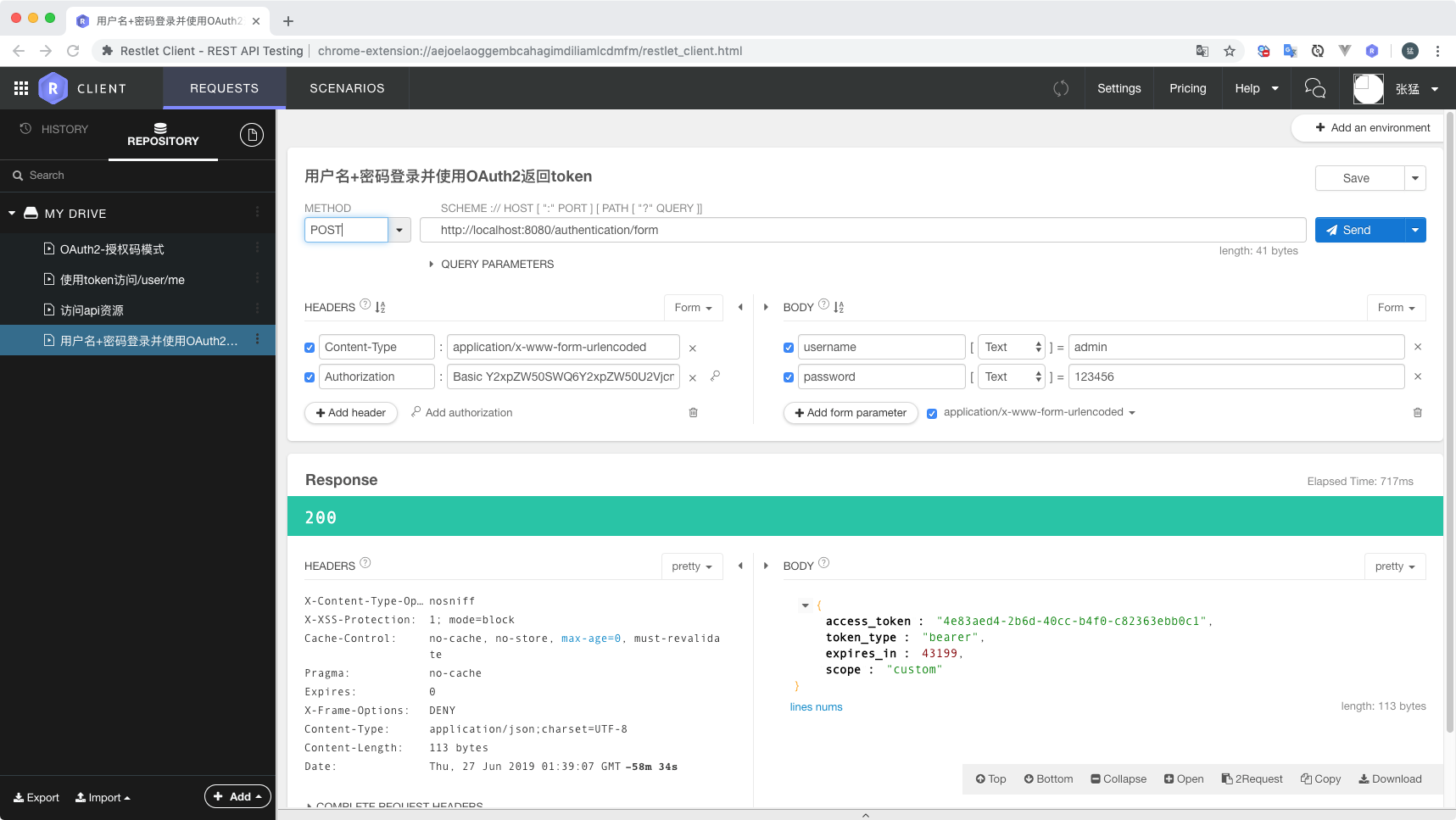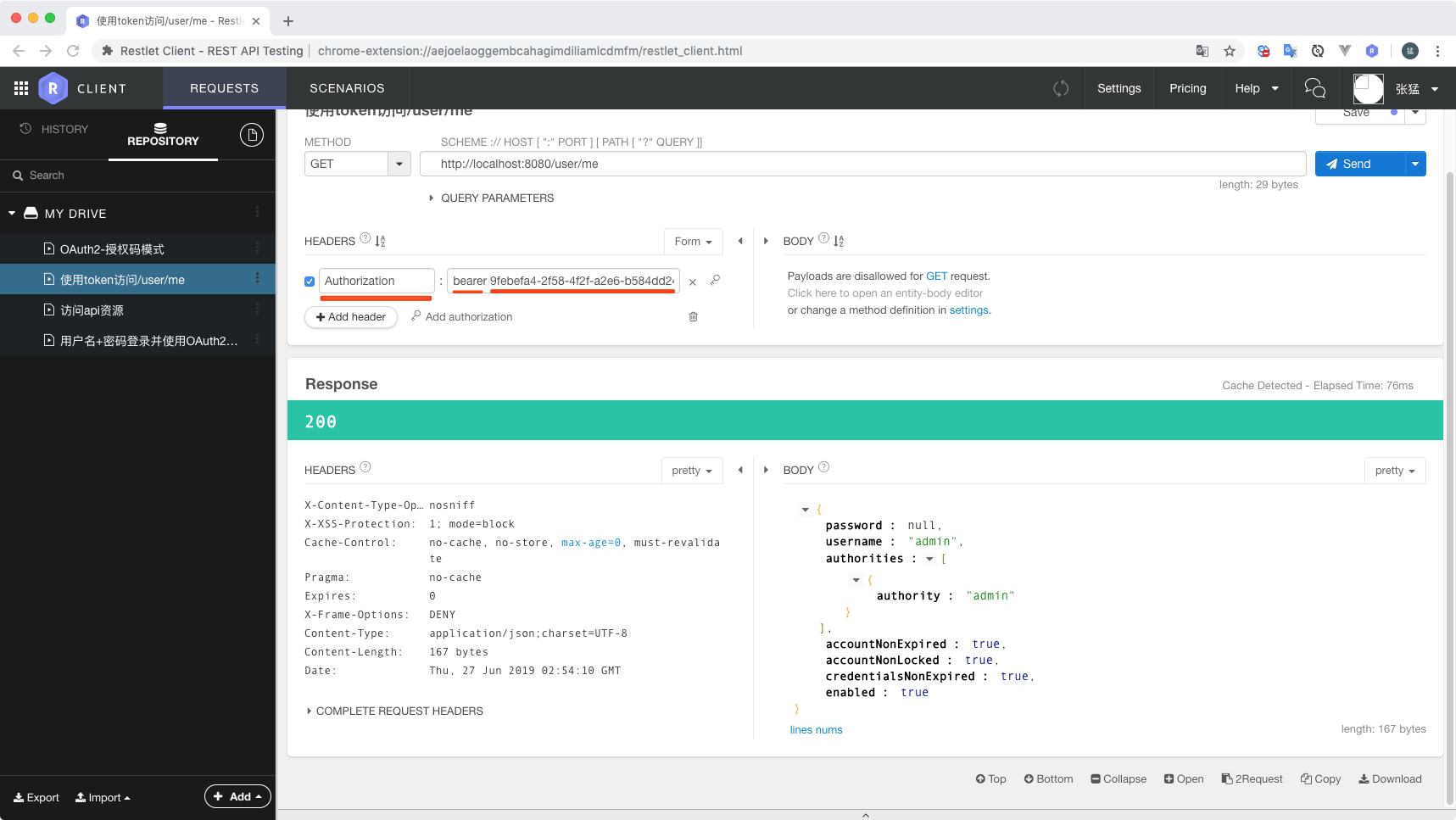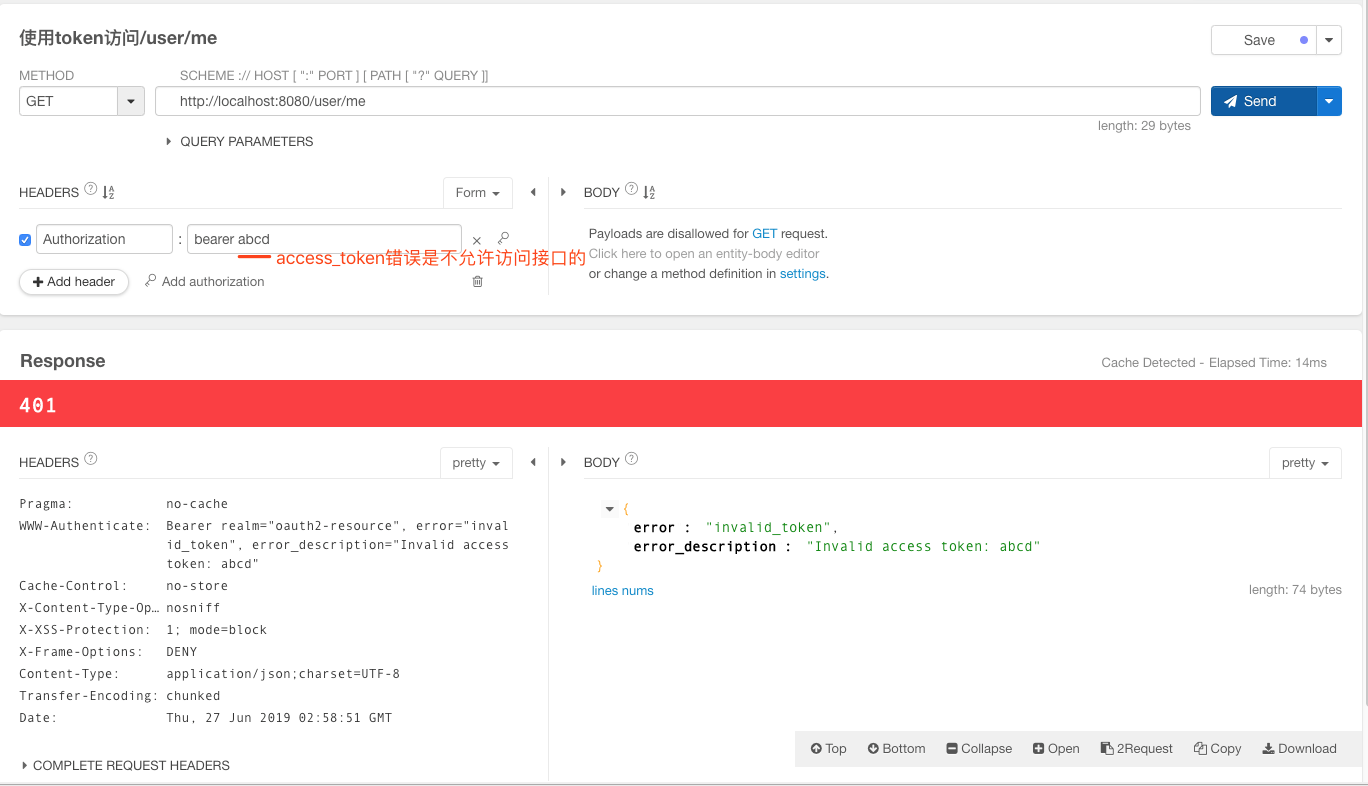上文讲了授权码模式,了解授权码模式可以很好的了解授权模式,但实际开发中也需要 "用户名+密码"方式来获取授权,本文将"用户名密码"这种方式接入到标准的OAuth2流程中,登录成功后返回token,根据token访问其它接口。
1. pom.xml
<?xml version="1.0" encoding="UTF-8"?>
<project xmlns="http://maven.apache.org/POM/4.0.0" xmlns:xsi="http://www.w3.org/2001/XMLSchema-instance"
xsi:schemaLocation="http://maven.apache.org/POM/4.0.0 http://maven.apache.org/xsd/maven-4.0.0.xsd">
<modelVersion>4.0.0</modelVersion>
<parent>
<groupId>org.springframework.boot</groupId>
<artifactId>spring-boot-starter-parent</artifactId>
<version>2.1.5.RELEASE</version>
<relativePath/> <!-- lookup parent from repository -->
</parent>
<groupId>com.example</groupId>
<artifactId>springboot-security-example</artifactId>
<version>0.0.1-SNAPSHOT</version>
<name>springboot-security-example</name>
<description>Demo project for Spring Boot</description>
<properties>
<java.version>1.8</java.version>
</properties>
<dependencies>
<dependency>
<groupId>org.springframework.boot</groupId>
<artifactId>spring-boot-starter-web</artifactId>
</dependency>
<dependency>
<groupId>org.springframework.boot</groupId>
<artifactId>spring-boot-starter-security</artifactId>
</dependency>
<dependency>
<groupId>org.springframework.security.oauth.boot</groupId>
<artifactId>spring-security-oauth2-autoconfigure</artifactId>
<version>2.1.2.RELEASE</version>
</dependency>
<dependency>
<groupId>org.springframework.security.oauth</groupId>
<artifactId>spring-security-oauth2</artifactId>
<version>2.3.4.RELEASE</version>
<scope>compile</scope>
</dependency>
<dependency>
<groupId>org.projectlombok</groupId>
<artifactId>lombok</artifactId>
</dependency>
<dependency>
<groupId>org.springframework.boot</groupId>
<artifactId>spring-boot-starter-test</artifactId>
</dependency>
</dependencies>
<build>
<plugins>
<plugin>
<groupId>org.springframework.boot</groupId>
<artifactId>spring-boot-maven-plugin</artifactId>
</plugin>
</plugins>
</build>
</project>
2. application.yml
server:
port: 8080
logging:
level:
org.springframework: debug
3. SecurityConfiguration
@Configuration
@EnableWebSecurity
public class SecurityConfiguration extends WebSecurityConfigurerAdapter {
@Autowired
private MyAuthenticationSuccessHandler myAuthenticationSuccessHandler;
@Autowired
private MyAuthenticationFailureHandler myAuthenticationFailureHandler;
@Autowired
private MyUserDetailsService myUserDetailsService;
@Override
protected void configure(HttpSecurity http) throws Exception {
http.formLogin()
.loginPage("/authentication/form")
.successHandler(myAuthenticationSuccessHandler)
.failureHandler(myAuthenticationFailureHandler);
http.authorizeRequests()
.antMatchers("/login", "/authentication/form").permitAll()
.anyRequest().authenticated()
.and().csrf().disable();
}
@Override
public void configure(AuthenticationManagerBuilder auth) throws Exception {
auth.userDetailsService(myUserDetailsService).passwordEncoder(passwordEncoder());
}
@Bean
public PasswordEncoder passwordEncoder(){
return new BCryptPasswordEncoder();
}
/**
* 对原始字符不进行加密,比较时都会返回true
*/
// @Bean
// public PasswordEncoder passwordEncoder() {
// return new PasswordEncoder() {
// @Override
// public String encode (CharSequence charSequence) {
// return charSequence.toString();
// }
// @Override
// public boolean matches(CharSequence charSequence, String s) {
// return true;
// }
// };
// }
}
4. UserDetailsService
@Component
public class MyUserDetailsService implements UserDetailsService {
@Autowired
private PasswordEncoder passwordEncoder;
@Override
public UserDetails loadUserByUsername(String username) throws UsernameNotFoundException {
return new User(username, passwordEncoder.encode("123456"), AuthorityUtils.commaSeparatedStringToAuthorityList("admin"));
}
public static void main(String[] args) {
System.out.println(new BCryptPasswordEncoder().encode("123456"));
}
}
5. AuthenticationSuccessHandler
@Slf4j
@Component
public class MyAuthenticationSuccessHandler extends SavedRequestAwareAuthenticationSuccessHandler {
@Autowired
private ObjectMapper objectMapper;
@Autowired
private ClientDetailsService clientDetailsService;
@Autowired
private AuthorizationServerTokenServices authorizationServerTokenServices;
@Override
public void onAuthenticationSuccess(HttpServletRequest request, HttpServletResponse response, Authentication authentication) throws IOException, ServletException {
log.info("login sucesssful {}", objectMapper.writeValueAsString(authentication));
String header = request.getHeader("Authorization");
if (header == null || !header.toLowerCase().startsWith("basic ")) {
throw new UnapprovedClientAuthenticationException("请求头中没有clientId");
}
String[] tokens = extractAndDecodeHeader(header, request);
assert tokens.length == 2;
String clientId = tokens[0];
String clientSecret = tokens[1];
ClientDetails clientDetails = clientDetailsService.loadClientByClientId(clientId);
if (clientDetails == null) {
throw new UnapprovedClientAuthenticationException("clientId配置信息不存在,clientId=" + clientId);
} else if (!new BCryptPasswordEncoder().matches(clientSecret, clientDetails.getClientSecret())) {
throw new UnapprovedClientAuthenticationException("clientSecret不匹配,clientId=" + clientId);
}
// grantType 为自定义的"custom"
TokenRequest tokenRequest = new TokenRequest(new HashMap<>(), clientId, clientDetails.getScope(), "custom");
OAuth2Request oAuth2Request = tokenRequest.createOAuth2Request(clientDetails);
OAuth2Authentication oAuth2Authentication = new OAuth2Authentication(oAuth2Request, authentication);
OAuth2AccessToken accessToken = authorizationServerTokenServices.createAccessToken(oAuth2Authentication);
response.setContentType("application/json;charset=UTF-8");
response.getWriter().write(objectMapper.writeValueAsString(accessToken));
}
/**
* Decodes the header into a username and password.
*
* @throws BadCredentialsException if the Basic header is not present or is not valid
* Base64
*/
private String[] extractAndDecodeHeader(String header, HttpServletRequest request)
throws IOException {
byte[] base64Token = header.substring(6).getBytes("UTF-8");
byte[] decoded;
try {
decoded = Base64.getDecoder().decode(base64Token);
}
catch (IllegalArgumentException e) {
throw new BadCredentialsException(
"Failed to decode basic authentication token");
}
String token = new String(decoded, "UTF-8");
int delim = token.indexOf(":");
if (delim == -1) {
throw new BadCredentialsException("Invalid basic authentication token");
}
return new String[] { token.substring(0, delim), token.substring(delim + 1) };
}
}
6. AuthenticationFailureHandler
@Slf4j
@Component
public class MyAuthenticationFailureHandler implements AuthenticationFailureHandler {
@Override
public void onAuthenticationFailure(HttpServletRequest request, HttpServletResponse response, AuthenticationException exception) throws IOException, ServletException {
log.info("认证失败");
response.setContentType("text/html;charset=utf-8");
response.getWriter().write(exception.getMessage());
}
}
7. AuthorizationServerConfiguration
@Configuration
@EnableAuthorizationServer
public class AuthorizationServerConfiguration extends AuthorizationServerConfigurerAdapter {
@Override
public void configure(ClientDetailsServiceConfigurer clients) throws Exception {
clients.inMemory() // 使用in-memory存储
.withClient("clientId")
.secret(new BCryptPasswordEncoder().encode("clientSecret"))
.authorizedGrantTypes("authorization_code")
.scopes("all")
.redirectUris("http://www.baidu.com");
}
@Override
public void configure(AuthorizationServerSecurityConfigurer security) throws Exception {
security
.tokenKeyAccess("permitAll()")
.checkTokenAccess("permitAll()")
.allowFormAuthenticationForClients();
}
}
8. ResourceServerConfiguration
- 资源服务器@EnableResourceServer用于保护接口,验证token,如果token有效就可以访问api
- 认证服务器@EnableAuthorizationServer用于获取token
- 资源服务器可以单独配置在要保护的项目上,也可以与认证服务器配置在同一个项目中
@Configuration
@EnableResourceServer
public class ResourceServerConfiguration extends ResourceServerConfigurerAdapter {
@Autowired
private MyAuthenticationSuccessHandler myAuthenticationSuccessHandler;
@Autowired
private MyAuthenticationFailureHandler myAuthenticationFailureHandler;
@Override
public void configure(HttpSecurity http) throws Exception {
http.formLogin()
.loginPage("/authentication/form")
.successHandler(myAuthenticationSuccessHandler)
.failureHandler(myAuthenticationFailureHandler);
http.authorizeRequests()
.antMatchers("/login", "/authentication/form").permitAll()
.anyRequest().authenticated()
.and().csrf().disable();
}
}
9. UserController
@RestController
public class UserController {
@Autowired
private ObjectMapper objectMapper;
@GetMapping(value = "/user/me", produces = MediaType.APPLICATION_JSON_UTF8_VALUE)
public String me() throws JsonProcessingException {
Authentication auth = SecurityContextHolder.getContext().getAuthentication();
Object principal = auth.getPrincipal();
return objectMapper.writeValueAsString(principal);
}
}
10. 获取token
访问登录地址"authentication/form"获取token, 这里使用Chome插件 rest api客户端来代替登录页面来发送登录请求。
- 登录地址在http.formLogin().loginPage(“authentication/form”)中配置
- username和password要和UserDetailsService中的值保持一致

Authorization中的Username和Password为AuthorizationServerConfiguration配置中的client和secret值。clients.inMemory().withClient("clientId").secret(new BCryptPasswordEncoder().encode("clientSecret"))

11. 访问资源接口
访问UserController中的接口"/user/me", 请求头中需要添加Authorization头,值为 "bearer " + access_token值,注意bearer字符串和access_token中间有个空格,access_token为上面获取token的的“access_token”字段值


